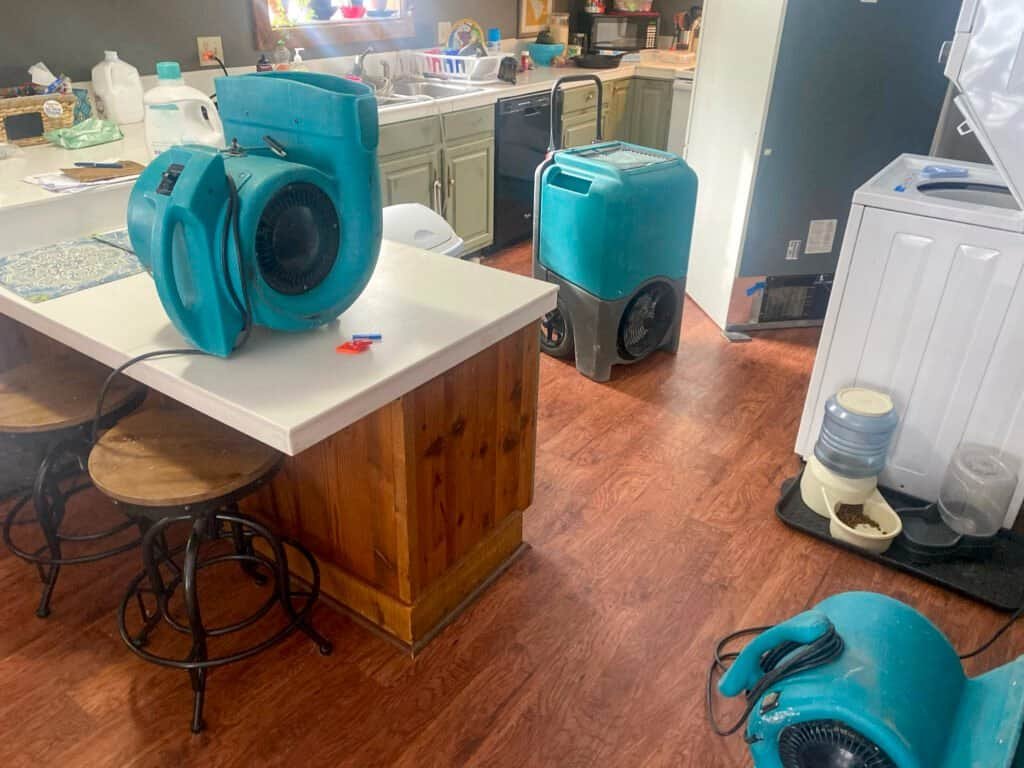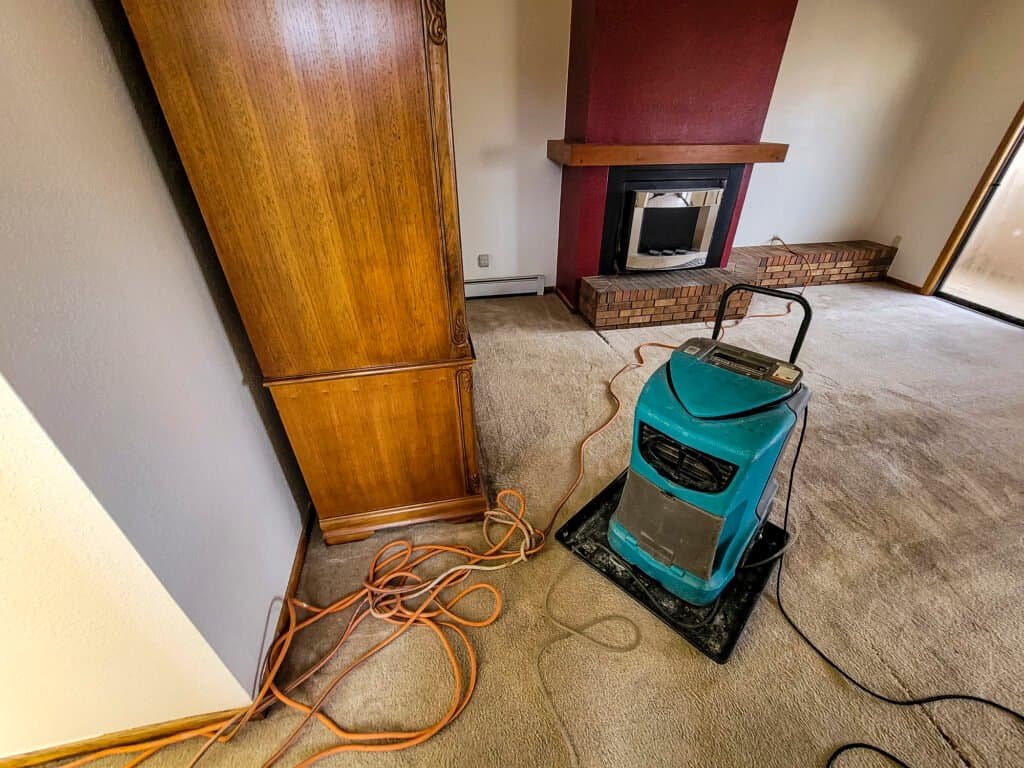Water Removal
Best Water Removal Services in the Area
Every water damage restoration project starts off with water removal. During this step, our experts will utilize water extraction equipment that will help you get rid off all floodwater or standing water wreaking havoc on your walls, floors, and furniture.
As standing water can pose as a big health risk to the ones exposed to it, it’s important that you call us so that the specialists we connect you with can get started with water removal ASAP!
We provide the following services:
A damp property might take anything from a few days to a few weeks to dry up, depending on how badly the water incursion was.
Keep in mind that there are many factors that will impact drying time, including the extent of the damage, severity of the damage (not the same), type of materials affected, etc.
In many cases, water damage will dry on its own in a matter of weeks. But just because the water evaporates doesn’t mean you should neglect the whole situation. Water can result in mold growth and other issues with your property if you don’t treat it right away.
Many people are unaware of how rapidly water damage can spread in a home, turning even a minor leak into a major issue. If water is not immediately removed from floors, walls, and furniture, it can cause structural damage, mold growth, and aesthetic problems.


How Is The Water Extracted?
How does water removal work?
Here’s a 1,000 foot view:
- Stopping the water: Water removal cannot begin until the source of the water is stopped. This can be as simple as turning off the main water pipe to your home, though certain situations may be more demanding.
- Draining the water: It is critical to remove visible pockets of water to prevent further damage to your property. This can be accomplished by using a wet vacuum or a pump to aid in the removal of water.
- Removing non-visible water: Even if you have successfully removed visible water from your home, the damage may continue undetected. Water can find itself in walls or other places it shouldn’t be in. This water will also be removed by our professionals.
Water Removal Equipment
The equipment used for professional water extraction may include:
- Truck-Mounted Extractors: These are powerful machines mounted on trucks and are capable of extracting large volumes of water quickly. They use high-pressure vacuum systems to remove water from carpets, padding, and subfloors.
- Portable Extractors: These are more versatile and can be used in various settings. They come in different sizes and capacities, making them suitable for both residential and commercial water extraction.
- Wand Extractors: These handheld tools are used in conjunction with portable or truck-mounted extractors to target specific damp areas, such as upholstery or tight spaces.
- Submersible Pumps: Submersible pumps are used to remove large volumes of standing water from basements, pools, or other areas where water has accumulated.
- Containment Barriers: Used to isolate affected areas and prevent cross-contamination, containment barriers may include plastic sheeting or temporary walls.
- Personal Protective Equipment (PPE): Technicians use appropriate PPE, such as gloves, masks, and waterproof boots, to protect themselves during the extraction process.
- Disposal Equipment: This includes pumps and containers for safely disposing of extracted water, especially if it’s contaminated.
Professional water extraction services may use a combination of these tools and equipment, depending on the specific situation and the extent of the water damage.
It’s essential to hire experienced professionals who have the knowledge and equipment to efficiently extract water and prevent further damage to your property.
This describes International City Water Damage Restoration perfectly! Call us for a quote now.


Will You Also Dehumidify My Room?
Yes! Dehumidification is essential because it helps to lower the humidity levels within the affected area back to normal. It’s not enough just for the standing water to be removed; the moisture that has permeated your walls, ceilings, floors, and furniture has to be removed too.
Dehumidification is typically done in conjunction with water extraction during water damage restoration. The process generally follows this sequence:
- Water Extraction: The first step is water removal done using the aforementioned equipment like pumps, extractors, and wet vacuums.
- Dehumidification: Once the bulk of the visible water is removed, dehumidification equipment, such as dehumidifiers and air movers, is deployed. Dehumidifiers work to extract moisture from the air, while air movers increase air circulation, aiding in the evaporation of residual moisture from surfaces and materials.
In summary, while water extraction focuses on the removal of standing water, dehumidification is a critical follow-up step to remove moisture from the air and materials.
To learn more about dehumidification, visit our page about structural drying.
Can I Remove the Water Myself?
Most likely, yes, although we wouldn’t recommend it, simply due to the risk of exposing yourself to potentially very contaminated water.
However, if you still wish to give it a shot, here’s how to do it:
To re-emphasize, DIY water removal and extraction can only be done for small-scale water damage situations, such as minor leaks or spills. Here are the steps to perform DIY water removal:
- Safety First:
- Before you begin, ensure your safety. Turn off the electricity to reduce the risk of electrical shock.
- Wear appropriate personal protective equipment (PPE), like rubber gloves and waterproof boots.
- Identify and Fix the Source:
- If the water damage is from a plumbing leak or malfunction, turn off the water supply. Repair the source of the leak or call a professional plumber.
- Remove Valuables:
- Safeguard valuable items or possessions in the affected area.
- Extract Standing Water:
- Use a wet vacuum or a mop and buckets to remove as much standing water as possible.
- Towels or rags can also be used to soak up smaller puddles.
- Open Windows and Promote Ventilation:
- If the weather is good, open windows and doors to improve air circulation and aid in the drying process.
- Use Fans:
- Target damp spots with fans.
- Dehumidify:
- Rent a dehumidifier and place it in a damaged room. Turn it on, monitor the tank, empty it when needed, and repeat the process until the room is dry.
- Remove Wet Materials:
- Discard materials that cannot be preserved, such as heavily water-damaged drywall or insulation. The reason you want these out is because they easily deteriorate if they get wet, and they can not be preserved at that point.
- Disinfect and Prevent Mold:
- Disinfect the affected area with a mixture of water and a mild detergent or a solution specifically designed for mold prevention. Consider using a mold inhibitor or fungicide on surfaces that may be susceptible to mold, which includes pretty much any organic materials.
- Monitor Progress:
- Continue to monitor the drying process. Ensure that the affected area is completely dry.
- Seek Professional Help:
- If the water damage is extensive, the source is unclear, or you’re uncertain about your ability to handle the situation, it’s best to call a professional restoration company for assistance.
There you go! Good luck. Again, if you’re struggling, call us to assist you.
